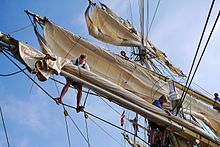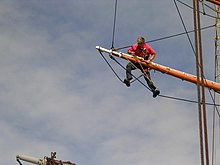Peerd
A peerd or horse is a rope that is attached under the yard and enables work on the yard.
The foot pear (foot horse) runs roughly parallel to the yard; on it stand the sailors who work on the yard. The jumping pear (jumping horse) is a vertically stretched short rope that is attached to the yard and holds the foot pear; This means that the distance between the foot and the yard remains more or less constant over the entire length of the row. At the nock (end of the yard) runs a short additional foot pear, the nock pear (Nockpferd). In bad weather, back pegs (back horses) could also be harnessed .
The peerd (horse), also known as the stallion , did not appear until the 17th century, but not on all yards at the same time. It was first mentioned in English descriptions in 1642. How exactly the development went is so far unknown and contradicting itself.
There is also the handpeerd (hand horse ), which is attached to the yard and is a short loop through which the seaman can put his arm when working on the yard and sails .
Individual evidence
- ^ Anderson, Rigging of ships, pp. 152-155
literature
- Roger Charles Anderson: The rigging of ships in the days of the spritsail topmast, 1600-1720 . Salem 1927 ( Google Books [accessed November 19, 2015]).
- Horst Menzel: foot horses on ships of the 17th and 18th centuries . In: Working group historical shipbuilding e. V. (Ed.): The logbook . No. 2 , 1991, ISSN 0175-7601 , pp. 47-54 .


